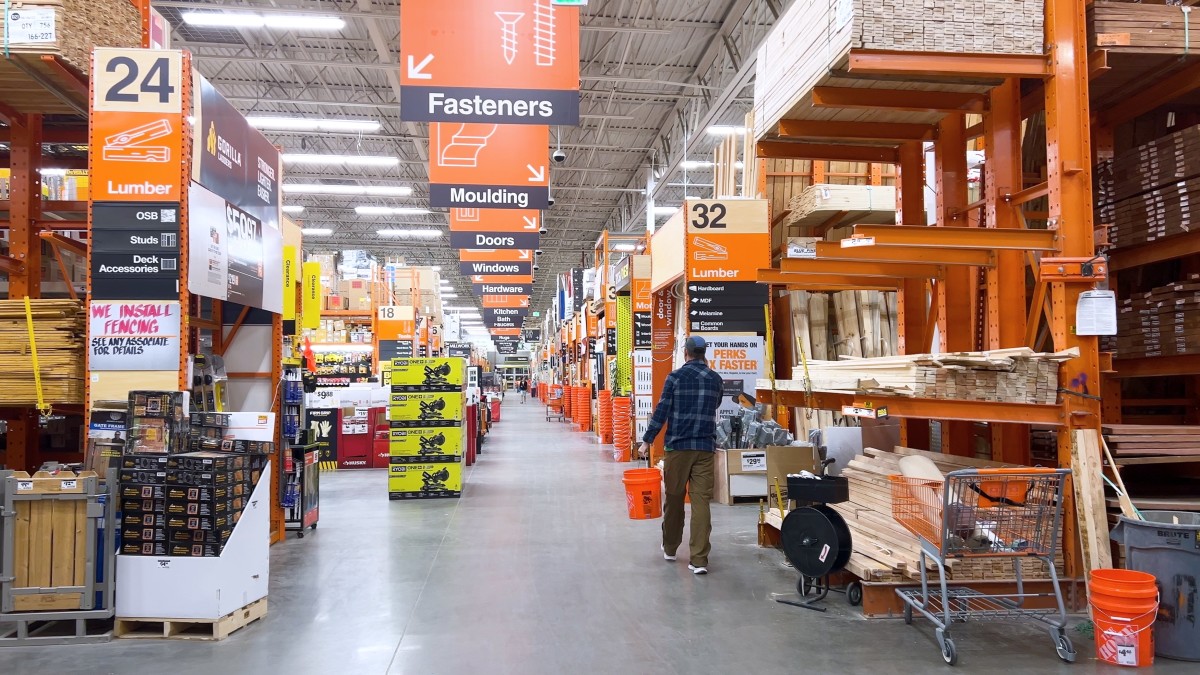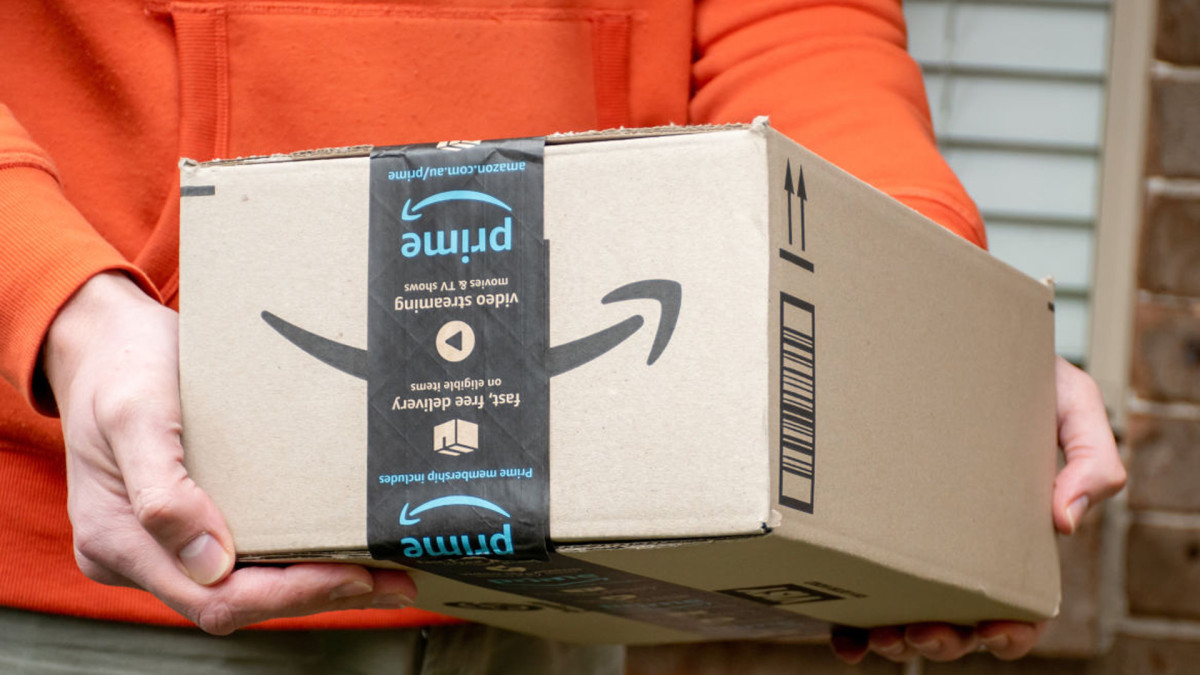Home Depot CEO sounds alarm on troubling customer trend in stores
Home Depot is struggling to reverse alarming customer behavior.

Home Depot has a growing problem in its stores. The retail chain is struggling to significantly increase its sales as it battles waning consumer demand, and its CEO is sounding the alarm on the main sources of the problem.
In Home Depot’s third-quarter earnings report for 2025, it revealed that its U.S. comparable sales increased by only 0.1% year-over-year, missing its expectations. Also, recent data from Placer.ai showed that foot traffic at Home Depot’s same-store locations dropped by 0.1% during the quarter, compared to the same time period last year.
Amid weak sales and declining foot traffic, Home Depot only generated an operating income of $5.3 billion, which is 1.2% less than what it earned during the same quarter in 2024. Shuttershock
Home Depot CEO calls out what’s causing weak demand
During an earnings call on Nov. 18, Home Depot CEO Ted Decker said that the company’s weak performance during the quarter was “primarily due to the lack of storms,” which impacted multiple areas of the business such as, plywood, roofing and power generation sales.
Last year, Home Depot saw a slight boost in sales during the third quarter due to consumers purchasing goods to prepare for hurricanes Helene and Milton, which devastated several southern states in September and October.
Decker said that Home Depot will continue to see lower sales for the rest of the year compared to the same time period in 2024.
“The storm activity and the rebuild and repair continued into Q4 (the fourth quarter) last year,” said Decker. “So we'll have even more storm pressure year-over-year in Q4.”
Related: Home Depot faces growing consumer boycott calls ahead of holidays
He also said that the company continues “to see softer engagement in larger discretionary projects where customers typically use financing to fund renovation projects,” mainly due to current challenges in the housing market.
“What's impacting us and home improvement is the ongoing pressure in housing, in incremental consumer uncertainty,” said Decker. “So take housing. I mean, housing has been soft for some time. We all know the higher interest rates and affordability concerns. But what we're seeing now is even less turnover, the housing activity is truly a 40-year low as a percentage of housing stock. I think we're at 2.9% turnover. And then home prices have started to adjust in even more markets over this past quarter.”
Decker said that the company is being affected by a $50 billion cumulative underspend in normal repair and remodel activity in U.S. housing.
Since 2022, the average 30-year mortgage rate in the U.S. has remained above 6%, leading many consumers to delay purchasing new homes as affordability declines.
How the U.S. housing market performed in October 2025:
- The average 30-year fixed-rate mortgage in October was 6.25%, down from 6.35% in September.
- Existing-home sales increased by 1.2% month-over-month in October.
- Specifically, month-over-month U.S. home sales rose in the Midwest and South, but stayed stagnant in the Northeast and fell in the West.
Sources: National Association of Realtors, Freddie Mac
"First-time homebuyers are facing headwinds in the Northeast due to a lack of supply and in the West because of high home prices," said NAR Chief Economist Lawrence Yun in a press release. "First-time buyers fared better in the Midwest because of the plentiful supply of affordable houses and in the South because there is sufficient inventory."
Home Depot CEO says customers are under pressure
Decker also said during the call that concerns about the high cost of living and the job market are putting additional pressure on consumers, which has impacted demand in Home Depot stores.
“We still believe we have one of the healthiest consumer segments in the whole economy,” said Decker. “But again, the economic uncertainty continues largely now due to living costs, affordability's a word that's being used a lot, layoffs, increased job concerns, etcetera. So that's why we don't see an uptick in that underlying storm-adjusted demand in the business.”
Home Depot’s weak performance during the quarter also comes after it implemented “modest” price increases in its stores a few months ago in response to President Doland Trump’s tariffs, which impacted about 50% of its products.
Many consumers nationwide have been reducing their spending as prices for everyday goods go up due to tariffs.
How U.S. consumers are battling tariffs in 2025:
- Approximately 87% of consumers are concerned about the impact of tariffs on their finances or shopping, while 63% are worried that tariffs will raise the price of everyday goods.
- Also, 82% of consumers plan to change their shopping habits in response to tariffs, which includes cutting back on nonessential spending, searching for sales or coupons, delaying nonessential or big-ticket purchases and switching to lower-priced retailers or discount stores.
- In addition, 77% are concerned about a recession within the next year.
Source: Numerator
“Changes in consumer sentiment are a leading indicator for changes in purchasing behaviors, and if consumers remain this pessimistic about the future of the U.S. economy, we can expect cutbacks in consumption going forward and a potential recession later this year,” said Numerator Chief Economist Leo Feler in a statement in April.
Home Depot recently made a major change to lure customers
To help attract customers during a time of economic uncertainty, Home Depot recently expanded its offerings for its Pro customers (residential and commercial professional contractors) through billion-dollar acquisitions.
In September, Home Depot acquired GMS, a major distributor of building products such as drywall, ceilings, steel framing and other complementary products for $5.5 billion. The move came after Home Depot acquired building material supplier SRS Distribution, which specializes in landscaping, roofing and pool construction products, for $18.25 billion in June last year.
The retailer hopes this strategy will encourage more customers to tackle large home improvement projects.
More Retail:
- Marshalls makes bold change to return policy ahead of holidays
- Walmart quietly shrinks generous offer for holiday shoppers
- BJ’s Wholesale announces free offer for customers amid struggles
During the earnings call, Decker said that the company will remain “focused on controlling what we can control” as it battles current headwinds.
“Our teams are executing at a high level, and we believe we are growing market share,” said Decker. “We continue to invest across the business, supporting our associates and delivering the value proposition expected by our customers.”
Home Depot now expects total sales for fiscal year 2025 to grow by about 3%, and adjusted diluted earnings per share to decline by roughly 5% compared to fiscal year 2024.
Related: Home Depot raises alarm bells with unexpected closure, layoffs
What's Your Reaction?





















































